Communicating in Health and Social Care: Theories and Practices
VerifiedAdded on 2019/12/18
|13
|4417
|179
Report
AI Summary
This report examines communication in health and social care, focusing on theories, practices, and barriers within the context of a case study involving Mrs. D and Park Day Centre. It explores various communication theories like Behavioral and Humanistic approaches, and discusses verbal and non-verbal communication methods, including the Shannon-Weaver model. The report highlights factors influencing communication, such as values, cultures, and legislation, and addresses potential barriers like language, jargon, and lack of trust. Strategies for effective communication are proposed, emphasizing the importance of tailored approaches for patients with specific needs, like Mrs. D's deafness. Furthermore, the influence of cultural values, legislation, and ethical considerations, including data protection and patient privacy, are discussed in promoting good communication practices. The report emphasizes the need for organizational systems and policies that encourage effective communication, ensuring patient understanding and fostering a supportive environment. The report also highlights the importance of factors such as age, ethnicity, gender, and legislation in the communication process.
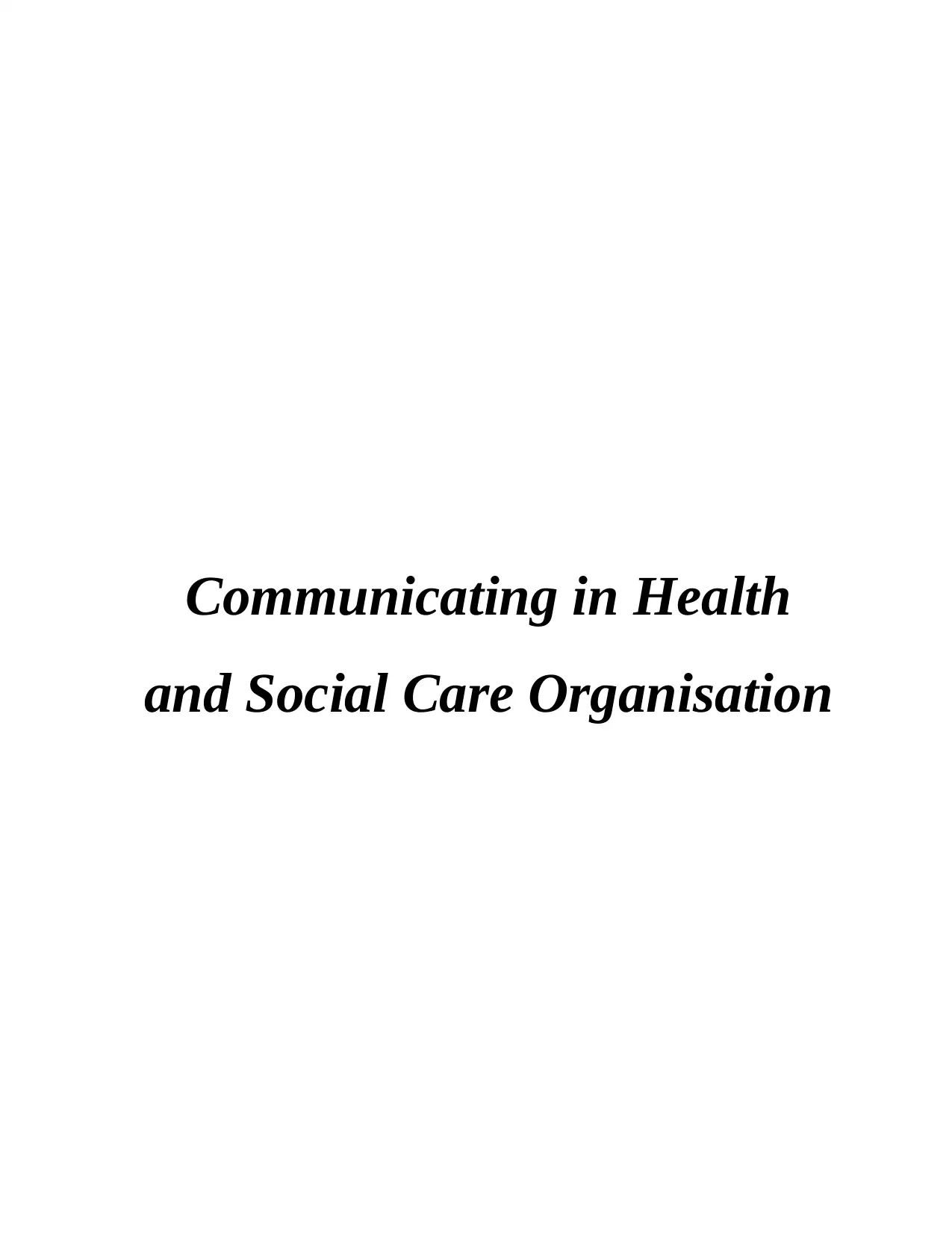
Communicating in Health
and Social Care Organisation
and Social Care Organisation
Paraphrase This Document
Need a fresh take? Get an instant paraphrase of this document with our AI Paraphraser
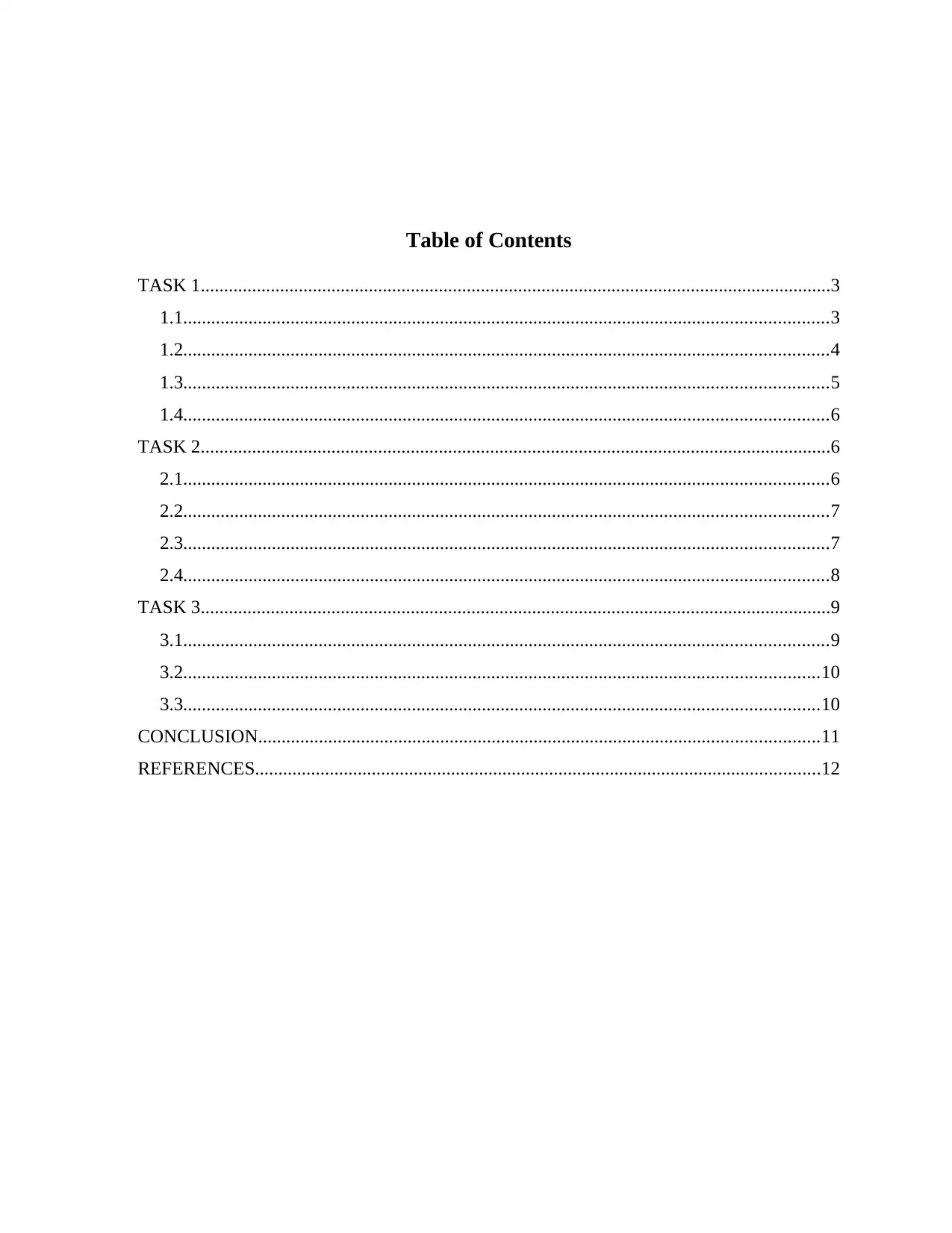
Table of Contents
TASK 1.......................................................................................................................................3
1.1..........................................................................................................................................3
1.2..........................................................................................................................................4
1.3..........................................................................................................................................5
1.4..........................................................................................................................................6
TASK 2.......................................................................................................................................6
2.1..........................................................................................................................................6
2.2..........................................................................................................................................7
2.3..........................................................................................................................................7
2.4..........................................................................................................................................8
TASK 3.......................................................................................................................................9
3.1..........................................................................................................................................9
3.2........................................................................................................................................10
3.3........................................................................................................................................10
CONCLUSION........................................................................................................................11
REFERENCES.........................................................................................................................12
TASK 1.......................................................................................................................................3
1.1..........................................................................................................................................3
1.2..........................................................................................................................................4
1.3..........................................................................................................................................5
1.4..........................................................................................................................................6
TASK 2.......................................................................................................................................6
2.1..........................................................................................................................................6
2.2..........................................................................................................................................7
2.3..........................................................................................................................................7
2.4..........................................................................................................................................8
TASK 3.......................................................................................................................................9
3.1..........................................................................................................................................9
3.2........................................................................................................................................10
3.3........................................................................................................................................10
CONCLUSION........................................................................................................................11
REFERENCES.........................................................................................................................12
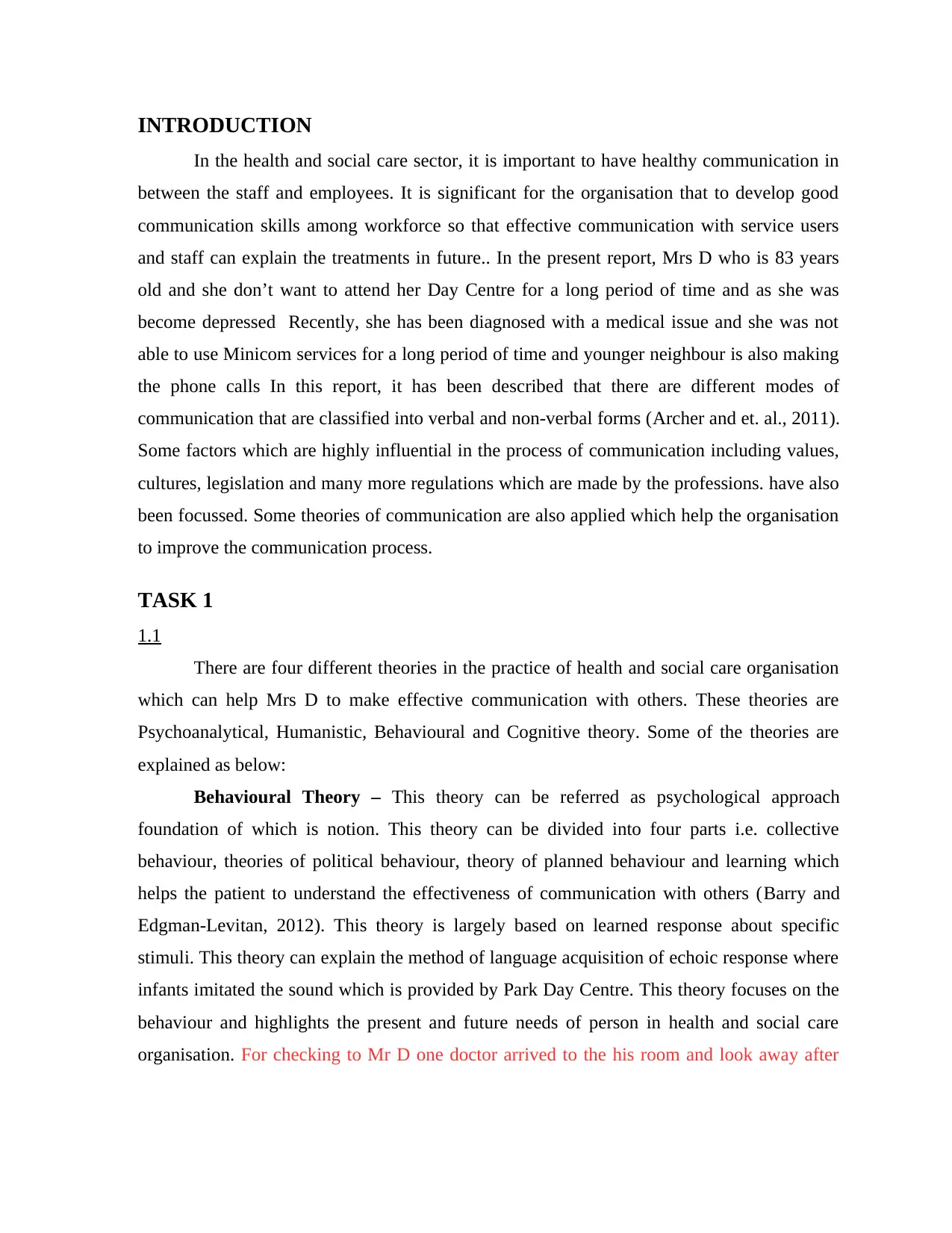
INTRODUCTION
In the health and social care sector, it is important to have healthy communication in
between the staff and employees. It is significant for the organisation that to develop good
communication skills among workforce so that effective communication with service users
and staff can explain the treatments in future.. In the present report, Mrs D who is 83 years
old and she don’t want to attend her Day Centre for a long period of time and as she was
become depressed Recently, she has been diagnosed with a medical issue and she was not
able to use Minicom services for a long period of time and younger neighbour is also making
the phone calls In this report, it has been described that there are different modes of
communication that are classified into verbal and non-verbal forms (Archer and et. al., 2011).
Some factors which are highly influential in the process of communication including values,
cultures, legislation and many more regulations which are made by the professions. have also
been focussed. Some theories of communication are also applied which help the organisation
to improve the communication process.
TASK 1
1.1
There are four different theories in the practice of health and social care organisation
which can help Mrs D to make effective communication with others. These theories are
Psychoanalytical, Humanistic, Behavioural and Cognitive theory. Some of the theories are
explained as below:
Behavioural Theory – This theory can be referred as psychological approach
foundation of which is notion. This theory can be divided into four parts i.e. collective
behaviour, theories of political behaviour, theory of planned behaviour and learning which
helps the patient to understand the effectiveness of communication with others (Barry and
Edgman-Levitan, 2012). This theory is largely based on learned response about specific
stimuli. This theory can explain the method of language acquisition of echoic response where
infants imitated the sound which is provided by Park Day Centre. This theory focuses on the
behaviour and highlights the present and future needs of person in health and social care
organisation. For checking to Mr D one doctor arrived to the his room and look away after
In the health and social care sector, it is important to have healthy communication in
between the staff and employees. It is significant for the organisation that to develop good
communication skills among workforce so that effective communication with service users
and staff can explain the treatments in future.. In the present report, Mrs D who is 83 years
old and she don’t want to attend her Day Centre for a long period of time and as she was
become depressed Recently, she has been diagnosed with a medical issue and she was not
able to use Minicom services for a long period of time and younger neighbour is also making
the phone calls In this report, it has been described that there are different modes of
communication that are classified into verbal and non-verbal forms (Archer and et. al., 2011).
Some factors which are highly influential in the process of communication including values,
cultures, legislation and many more regulations which are made by the professions. have also
been focussed. Some theories of communication are also applied which help the organisation
to improve the communication process.
TASK 1
1.1
There are four different theories in the practice of health and social care organisation
which can help Mrs D to make effective communication with others. These theories are
Psychoanalytical, Humanistic, Behavioural and Cognitive theory. Some of the theories are
explained as below:
Behavioural Theory – This theory can be referred as psychological approach
foundation of which is notion. This theory can be divided into four parts i.e. collective
behaviour, theories of political behaviour, theory of planned behaviour and learning which
helps the patient to understand the effectiveness of communication with others (Barry and
Edgman-Levitan, 2012). This theory is largely based on learned response about specific
stimuli. This theory can explain the method of language acquisition of echoic response where
infants imitated the sound which is provided by Park Day Centre. This theory focuses on the
behaviour and highlights the present and future needs of person in health and social care
organisation. For checking to Mr D one doctor arrived to the his room and look away after
⊘ This is a preview!⊘
Do you want full access?
Subscribe today to unlock all pages.

Trusted by 1+ million students worldwide
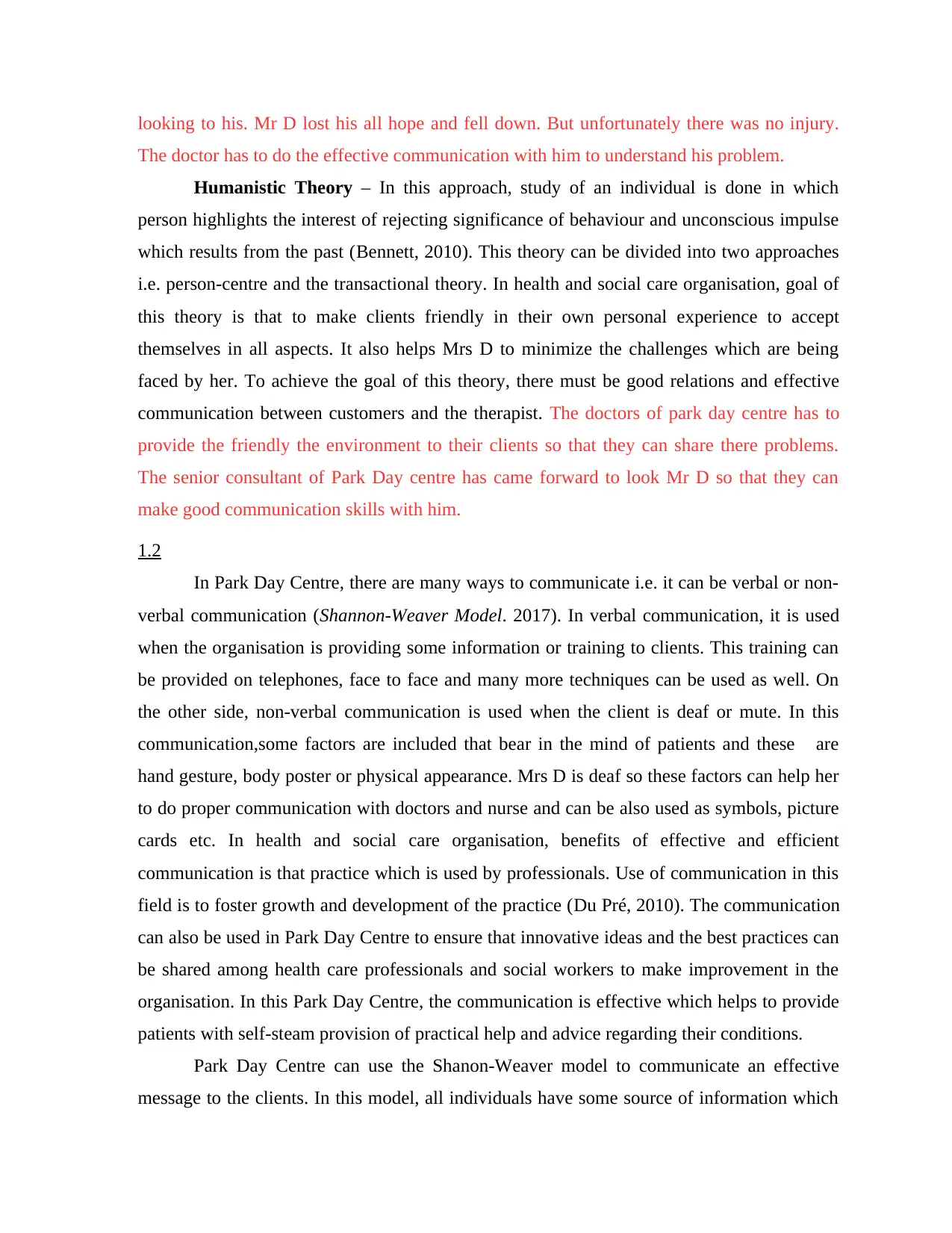
looking to his. Mr D lost his all hope and fell down. But unfortunately there was no injury.
The doctor has to do the effective communication with him to understand his problem.
Humanistic Theory – In this approach, study of an individual is done in which
person highlights the interest of rejecting significance of behaviour and unconscious impulse
which results from the past (Bennett, 2010). This theory can be divided into two approaches
i.e. person-centre and the transactional theory. In health and social care organisation, goal of
this theory is that to make clients friendly in their own personal experience to accept
themselves in all aspects. It also helps Mrs D to minimize the challenges which are being
faced by her. To achieve the goal of this theory, there must be good relations and effective
communication between customers and the therapist. The doctors of park day centre has to
provide the friendly the environment to their clients so that they can share there problems.
The senior consultant of Park Day centre has came forward to look Mr D so that they can
make good communication skills with him.
1.2
In Park Day Centre, there are many ways to communicate i.e. it can be verbal or non-
verbal communication (Shannon-Weaver Model. 2017). In verbal communication, it is used
when the organisation is providing some information or training to clients. This training can
be provided on telephones, face to face and many more techniques can be used as well. On
the other side, non-verbal communication is used when the client is deaf or mute. In this
communication,some factors are included that bear in the mind of patients and these are
hand gesture, body poster or physical appearance. Mrs D is deaf so these factors can help her
to do proper communication with doctors and nurse and can be also used as symbols, picture
cards etc. In health and social care organisation, benefits of effective and efficient
communication is that practice which is used by professionals. Use of communication in this
field is to foster growth and development of the practice (Du Pré, 2010). The communication
can also be used in Park Day Centre to ensure that innovative ideas and the best practices can
be shared among health care professionals and social workers to make improvement in the
organisation. In this Park Day Centre, the communication is effective which helps to provide
patients with self-steam provision of practical help and advice regarding their conditions.
Park Day Centre can use the Shanon-Weaver model to communicate an effective
message to the clients. In this model, all individuals have some source of information which
The doctor has to do the effective communication with him to understand his problem.
Humanistic Theory – In this approach, study of an individual is done in which
person highlights the interest of rejecting significance of behaviour and unconscious impulse
which results from the past (Bennett, 2010). This theory can be divided into two approaches
i.e. person-centre and the transactional theory. In health and social care organisation, goal of
this theory is that to make clients friendly in their own personal experience to accept
themselves in all aspects. It also helps Mrs D to minimize the challenges which are being
faced by her. To achieve the goal of this theory, there must be good relations and effective
communication between customers and the therapist. The doctors of park day centre has to
provide the friendly the environment to their clients so that they can share there problems.
The senior consultant of Park Day centre has came forward to look Mr D so that they can
make good communication skills with him.
1.2
In Park Day Centre, there are many ways to communicate i.e. it can be verbal or non-
verbal communication (Shannon-Weaver Model. 2017). In verbal communication, it is used
when the organisation is providing some information or training to clients. This training can
be provided on telephones, face to face and many more techniques can be used as well. On
the other side, non-verbal communication is used when the client is deaf or mute. In this
communication,some factors are included that bear in the mind of patients and these are
hand gesture, body poster or physical appearance. Mrs D is deaf so these factors can help her
to do proper communication with doctors and nurse and can be also used as symbols, picture
cards etc. In health and social care organisation, benefits of effective and efficient
communication is that practice which is used by professionals. Use of communication in this
field is to foster growth and development of the practice (Du Pré, 2010). The communication
can also be used in Park Day Centre to ensure that innovative ideas and the best practices can
be shared among health care professionals and social workers to make improvement in the
organisation. In this Park Day Centre, the communication is effective which helps to provide
patients with self-steam provision of practical help and advice regarding their conditions.
Park Day Centre can use the Shanon-Weaver model to communicate an effective
message to the clients. In this model, all individuals have some source of information which
Paraphrase This Document
Need a fresh take? Get an instant paraphrase of this document with our AI Paraphraser
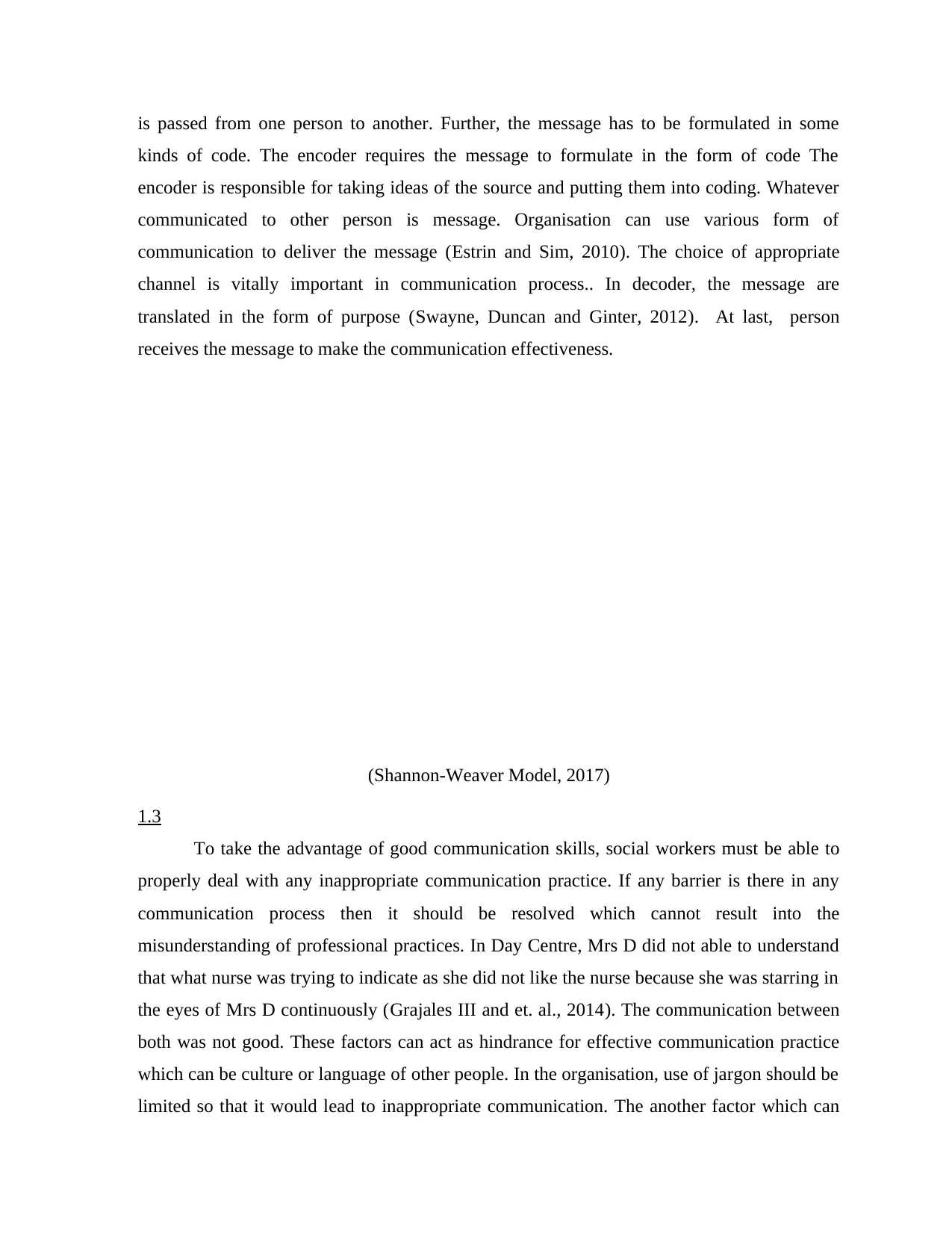
is passed from one person to another. Further, the message has to be formulated in some
kinds of code. The encoder requires the message to formulate in the form of code The
encoder is responsible for taking ideas of the source and putting them into coding. Whatever
communicated to other person is message. Organisation can use various form of
communication to deliver the message (Estrin and Sim, 2010). The choice of appropriate
channel is vitally important in communication process.. In decoder, the message are
translated in the form of purpose (Swayne, Duncan and Ginter, 2012). At last, person
receives the message to make the communication effectiveness.
(Shannon-Weaver Model, 2017)
1.3
To take the advantage of good communication skills, social workers must be able to
properly deal with any inappropriate communication practice. If any barrier is there in any
communication process then it should be resolved which cannot result into the
misunderstanding of professional practices. In Day Centre, Mrs D did not able to understand
that what nurse was trying to indicate as she did not like the nurse because she was starring in
the eyes of Mrs D continuously (Grajales III and et. al., 2014). The communication between
both was not good. These factors can act as hindrance for effective communication practice
which can be culture or language of other people. In the organisation, use of jargon should be
limited so that it would lead to inappropriate communication. The another factor which can
kinds of code. The encoder requires the message to formulate in the form of code The
encoder is responsible for taking ideas of the source and putting them into coding. Whatever
communicated to other person is message. Organisation can use various form of
communication to deliver the message (Estrin and Sim, 2010). The choice of appropriate
channel is vitally important in communication process.. In decoder, the message are
translated in the form of purpose (Swayne, Duncan and Ginter, 2012). At last, person
receives the message to make the communication effectiveness.
(Shannon-Weaver Model, 2017)
1.3
To take the advantage of good communication skills, social workers must be able to
properly deal with any inappropriate communication practice. If any barrier is there in any
communication process then it should be resolved which cannot result into the
misunderstanding of professional practices. In Day Centre, Mrs D did not able to understand
that what nurse was trying to indicate as she did not like the nurse because she was starring in
the eyes of Mrs D continuously (Grajales III and et. al., 2014). The communication between
both was not good. These factors can act as hindrance for effective communication practice
which can be culture or language of other people. In the organisation, use of jargon should be
limited so that it would lead to inappropriate communication. The another factor which can
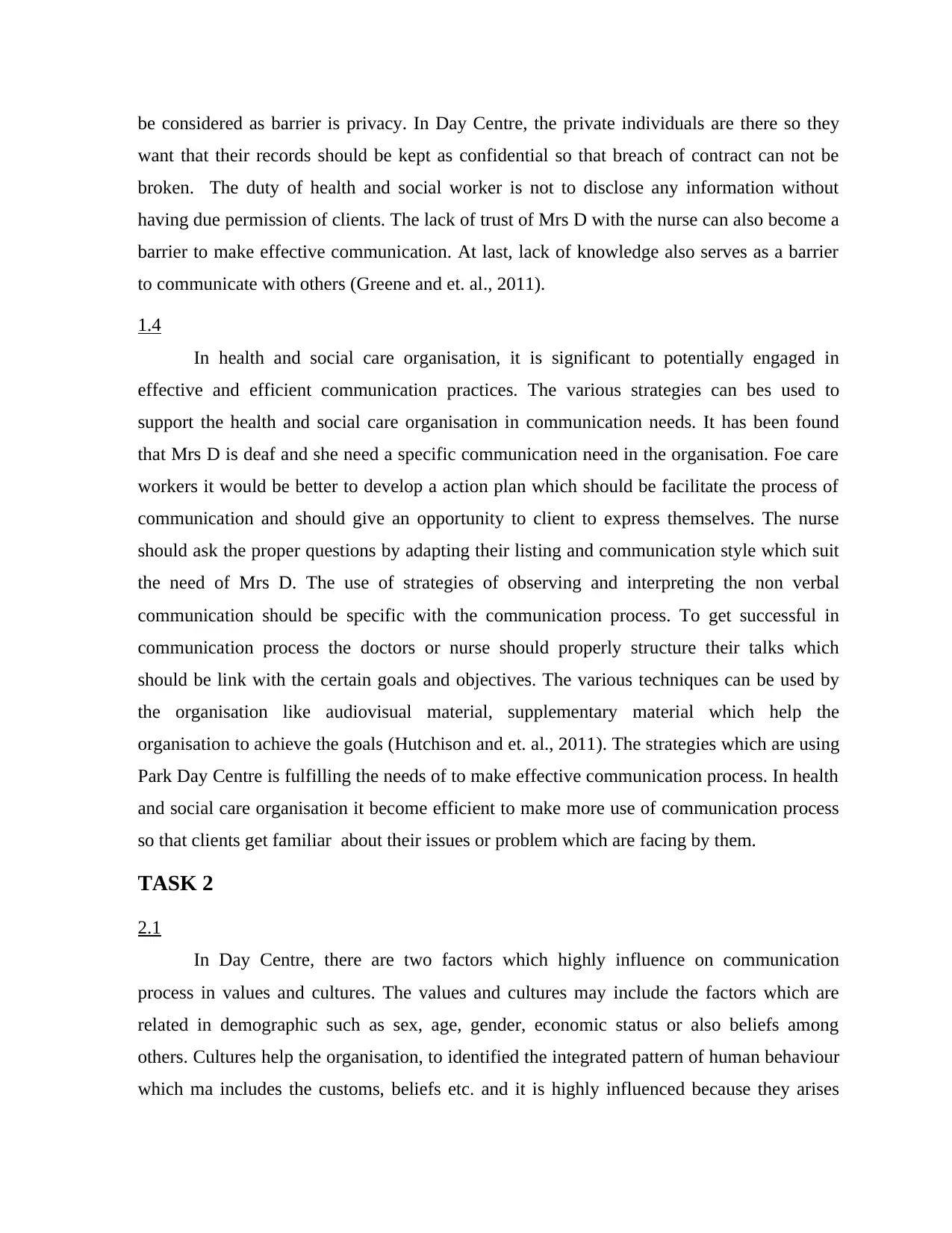
be considered as barrier is privacy. In Day Centre, the private individuals are there so they
want that their records should be kept as confidential so that breach of contract can not be
broken. The duty of health and social worker is not to disclose any information without
having due permission of clients. The lack of trust of Mrs D with the nurse can also become a
barrier to make effective communication. At last, lack of knowledge also serves as a barrier
to communicate with others (Greene and et. al., 2011).
1.4
In health and social care organisation, it is significant to potentially engaged in
effective and efficient communication practices. The various strategies can bes used to
support the health and social care organisation in communication needs. It has been found
that Mrs D is deaf and she need a specific communication need in the organisation. Foe care
workers it would be better to develop a action plan which should be facilitate the process of
communication and should give an opportunity to client to express themselves. The nurse
should ask the proper questions by adapting their listing and communication style which suit
the need of Mrs D. The use of strategies of observing and interpreting the non verbal
communication should be specific with the communication process. To get successful in
communication process the doctors or nurse should properly structure their talks which
should be link with the certain goals and objectives. The various techniques can be used by
the organisation like audiovisual material, supplementary material which help the
organisation to achieve the goals (Hutchison and et. al., 2011). The strategies which are using
Park Day Centre is fulfilling the needs of to make effective communication process. In health
and social care organisation it become efficient to make more use of communication process
so that clients get familiar about their issues or problem which are facing by them.
TASK 2
2.1
In Day Centre, there are two factors which highly influence on communication
process in values and cultures. The values and cultures may include the factors which are
related in demographic such as sex, age, gender, economic status or also beliefs among
others. Cultures help the organisation, to identified the integrated pattern of human behaviour
which ma includes the customs, beliefs etc. and it is highly influenced because they arises
want that their records should be kept as confidential so that breach of contract can not be
broken. The duty of health and social worker is not to disclose any information without
having due permission of clients. The lack of trust of Mrs D with the nurse can also become a
barrier to make effective communication. At last, lack of knowledge also serves as a barrier
to communicate with others (Greene and et. al., 2011).
1.4
In health and social care organisation, it is significant to potentially engaged in
effective and efficient communication practices. The various strategies can bes used to
support the health and social care organisation in communication needs. It has been found
that Mrs D is deaf and she need a specific communication need in the organisation. Foe care
workers it would be better to develop a action plan which should be facilitate the process of
communication and should give an opportunity to client to express themselves. The nurse
should ask the proper questions by adapting their listing and communication style which suit
the need of Mrs D. The use of strategies of observing and interpreting the non verbal
communication should be specific with the communication process. To get successful in
communication process the doctors or nurse should properly structure their talks which
should be link with the certain goals and objectives. The various techniques can be used by
the organisation like audiovisual material, supplementary material which help the
organisation to achieve the goals (Hutchison and et. al., 2011). The strategies which are using
Park Day Centre is fulfilling the needs of to make effective communication process. In health
and social care organisation it become efficient to make more use of communication process
so that clients get familiar about their issues or problem which are facing by them.
TASK 2
2.1
In Day Centre, there are two factors which highly influence on communication
process in values and cultures. The values and cultures may include the factors which are
related in demographic such as sex, age, gender, economic status or also beliefs among
others. Cultures help the organisation, to identified the integrated pattern of human behaviour
which ma includes the customs, beliefs etc. and it is highly influenced because they arises
⊘ This is a preview!⊘
Do you want full access?
Subscribe today to unlock all pages.

Trusted by 1+ million students worldwide
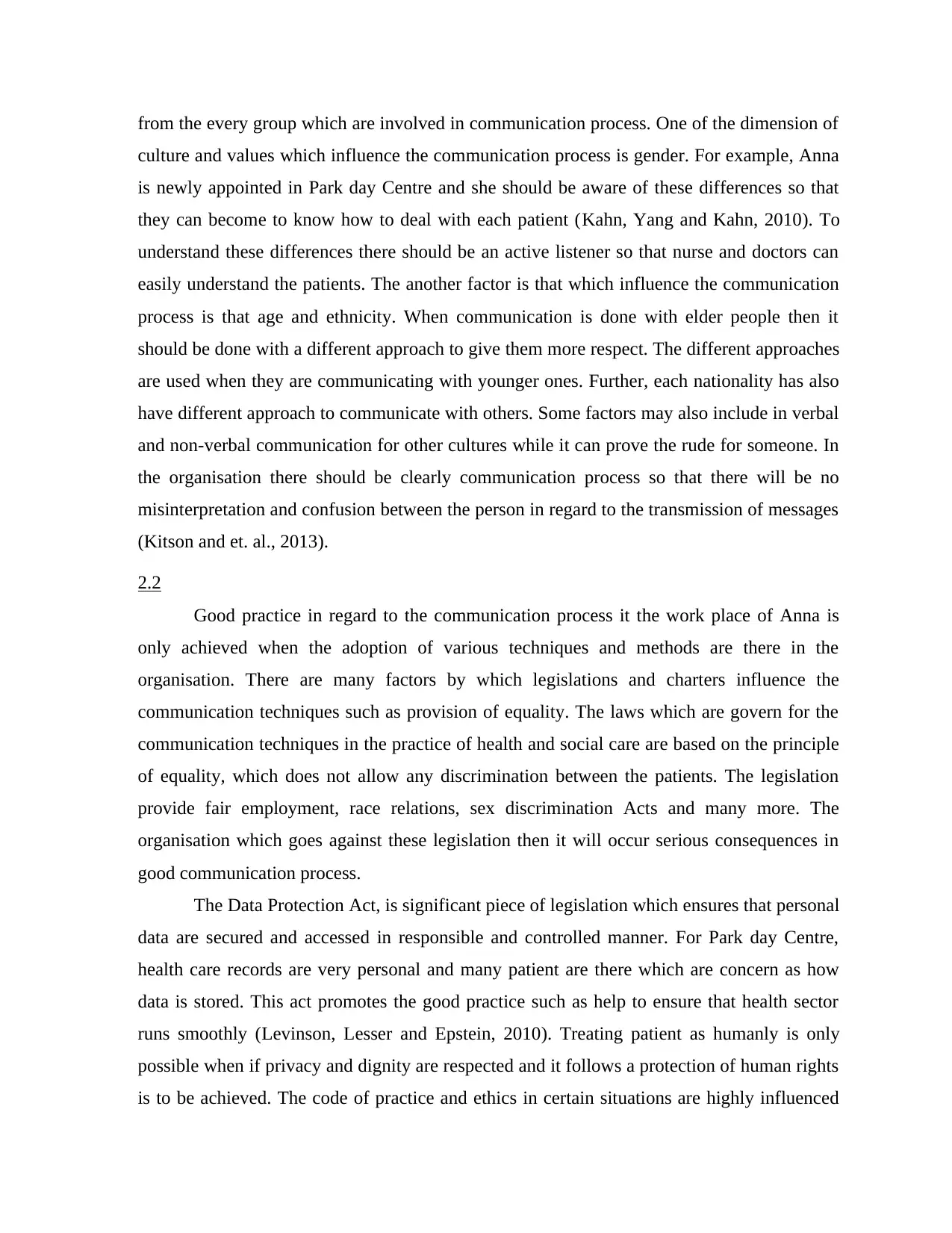
from the every group which are involved in communication process. One of the dimension of
culture and values which influence the communication process is gender. For example, Anna
is newly appointed in Park day Centre and she should be aware of these differences so that
they can become to know how to deal with each patient (Kahn, Yang and Kahn, 2010). To
understand these differences there should be an active listener so that nurse and doctors can
easily understand the patients. The another factor is that which influence the communication
process is that age and ethnicity. When communication is done with elder people then it
should be done with a different approach to give them more respect. The different approaches
are used when they are communicating with younger ones. Further, each nationality has also
have different approach to communicate with others. Some factors may also include in verbal
and non-verbal communication for other cultures while it can prove the rude for someone. In
the organisation there should be clearly communication process so that there will be no
misinterpretation and confusion between the person in regard to the transmission of messages
(Kitson and et. al., 2013).
2.2
Good practice in regard to the communication process it the work place of Anna is
only achieved when the adoption of various techniques and methods are there in the
organisation. There are many factors by which legislations and charters influence the
communication techniques such as provision of equality. The laws which are govern for the
communication techniques in the practice of health and social care are based on the principle
of equality, which does not allow any discrimination between the patients. The legislation
provide fair employment, race relations, sex discrimination Acts and many more. The
organisation which goes against these legislation then it will occur serious consequences in
good communication process.
The Data Protection Act, is significant piece of legislation which ensures that personal
data are secured and accessed in responsible and controlled manner. For Park day Centre,
health care records are very personal and many patient are there which are concern as how
data is stored. This act promotes the good practice such as help to ensure that health sector
runs smoothly (Levinson, Lesser and Epstein, 2010). Treating patient as humanly is only
possible when if privacy and dignity are respected and it follows a protection of human rights
is to be achieved. The code of practice and ethics in certain situations are highly influenced
culture and values which influence the communication process is gender. For example, Anna
is newly appointed in Park day Centre and she should be aware of these differences so that
they can become to know how to deal with each patient (Kahn, Yang and Kahn, 2010). To
understand these differences there should be an active listener so that nurse and doctors can
easily understand the patients. The another factor is that which influence the communication
process is that age and ethnicity. When communication is done with elder people then it
should be done with a different approach to give them more respect. The different approaches
are used when they are communicating with younger ones. Further, each nationality has also
have different approach to communicate with others. Some factors may also include in verbal
and non-verbal communication for other cultures while it can prove the rude for someone. In
the organisation there should be clearly communication process so that there will be no
misinterpretation and confusion between the person in regard to the transmission of messages
(Kitson and et. al., 2013).
2.2
Good practice in regard to the communication process it the work place of Anna is
only achieved when the adoption of various techniques and methods are there in the
organisation. There are many factors by which legislations and charters influence the
communication techniques such as provision of equality. The laws which are govern for the
communication techniques in the practice of health and social care are based on the principle
of equality, which does not allow any discrimination between the patients. The legislation
provide fair employment, race relations, sex discrimination Acts and many more. The
organisation which goes against these legislation then it will occur serious consequences in
good communication process.
The Data Protection Act, is significant piece of legislation which ensures that personal
data are secured and accessed in responsible and controlled manner. For Park day Centre,
health care records are very personal and many patient are there which are concern as how
data is stored. This act promotes the good practice such as help to ensure that health sector
runs smoothly (Levinson, Lesser and Epstein, 2010). Treating patient as humanly is only
possible when if privacy and dignity are respected and it follows a protection of human rights
is to be achieved. The code of practice and ethics in certain situations are highly influenced
Paraphrase This Document
Need a fresh take? Get an instant paraphrase of this document with our AI Paraphraser
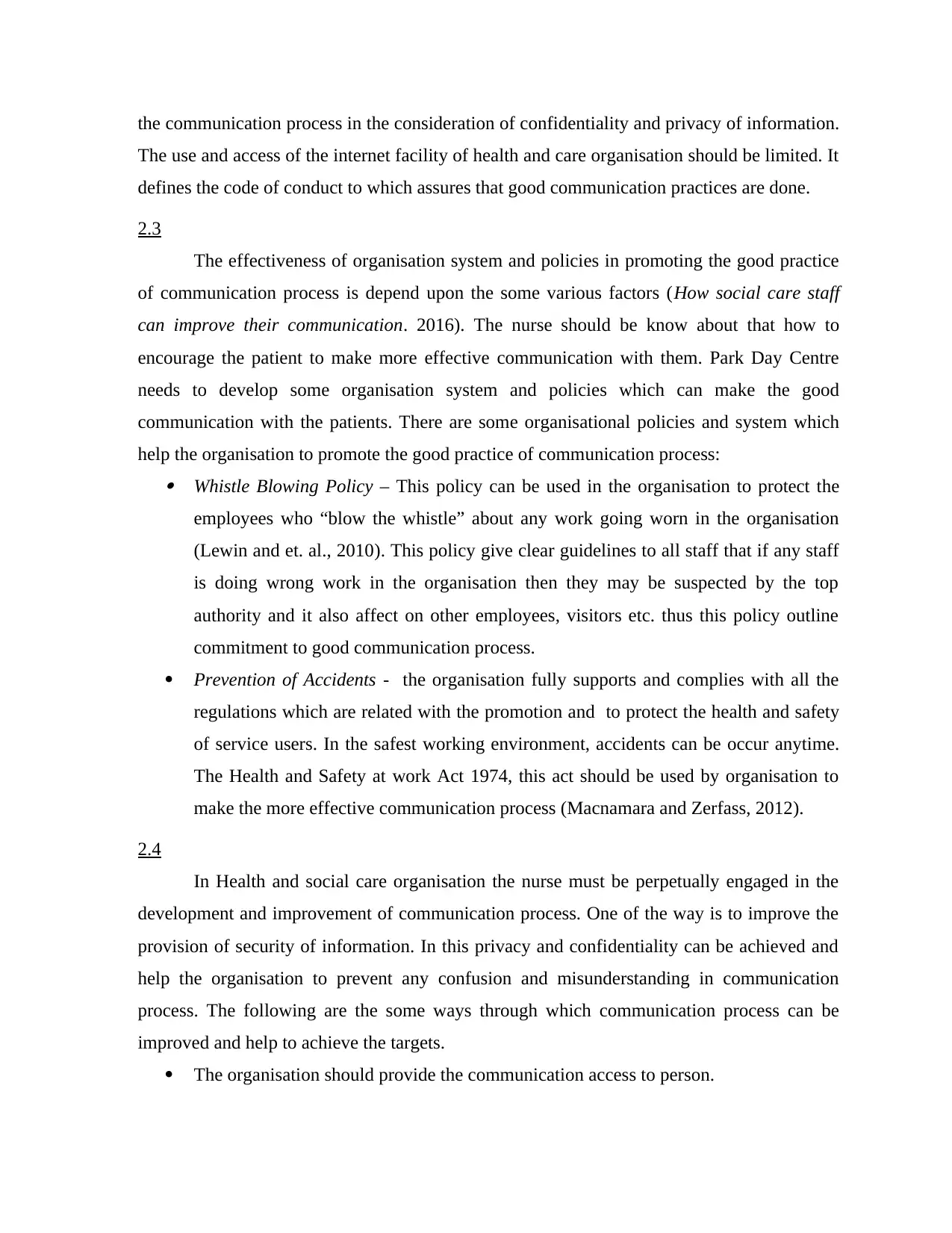
the communication process in the consideration of confidentiality and privacy of information.
The use and access of the internet facility of health and care organisation should be limited. It
defines the code of conduct to which assures that good communication practices are done.
2.3
The effectiveness of organisation system and policies in promoting the good practice
of communication process is depend upon the some various factors (How social care staff
can improve their communication. 2016). The nurse should be know about that how to
encourage the patient to make more effective communication with them. Park Day Centre
needs to develop some organisation system and policies which can make the good
communication with the patients. There are some organisational policies and system which
help the organisation to promote the good practice of communication process:
Whistle Blowing Policy – This policy can be used in the organisation to protect the
employees who “blow the whistle” about any work going worn in the organisation
(Lewin and et. al., 2010). This policy give clear guidelines to all staff that if any staff
is doing wrong work in the organisation then they may be suspected by the top
authority and it also affect on other employees, visitors etc. thus this policy outline
commitment to good communication process.
Prevention of Accidents - the organisation fully supports and complies with all the
regulations which are related with the promotion and to protect the health and safety
of service users. In the safest working environment, accidents can be occur anytime.
The Health and Safety at work Act 1974, this act should be used by organisation to
make the more effective communication process (Macnamara and Zerfass, 2012).
2.4
In Health and social care organisation the nurse must be perpetually engaged in the
development and improvement of communication process. One of the way is to improve the
provision of security of information. In this privacy and confidentiality can be achieved and
help the organisation to prevent any confusion and misunderstanding in communication
process. The following are the some ways through which communication process can be
improved and help to achieve the targets.
The organisation should provide the communication access to person.
The use and access of the internet facility of health and care organisation should be limited. It
defines the code of conduct to which assures that good communication practices are done.
2.3
The effectiveness of organisation system and policies in promoting the good practice
of communication process is depend upon the some various factors (How social care staff
can improve their communication. 2016). The nurse should be know about that how to
encourage the patient to make more effective communication with them. Park Day Centre
needs to develop some organisation system and policies which can make the good
communication with the patients. There are some organisational policies and system which
help the organisation to promote the good practice of communication process:
Whistle Blowing Policy – This policy can be used in the organisation to protect the
employees who “blow the whistle” about any work going worn in the organisation
(Lewin and et. al., 2010). This policy give clear guidelines to all staff that if any staff
is doing wrong work in the organisation then they may be suspected by the top
authority and it also affect on other employees, visitors etc. thus this policy outline
commitment to good communication process.
Prevention of Accidents - the organisation fully supports and complies with all the
regulations which are related with the promotion and to protect the health and safety
of service users. In the safest working environment, accidents can be occur anytime.
The Health and Safety at work Act 1974, this act should be used by organisation to
make the more effective communication process (Macnamara and Zerfass, 2012).
2.4
In Health and social care organisation the nurse must be perpetually engaged in the
development and improvement of communication process. One of the way is to improve the
provision of security of information. In this privacy and confidentiality can be achieved and
help the organisation to prevent any confusion and misunderstanding in communication
process. The following are the some ways through which communication process can be
improved and help to achieve the targets.
The organisation should provide the communication access to person.
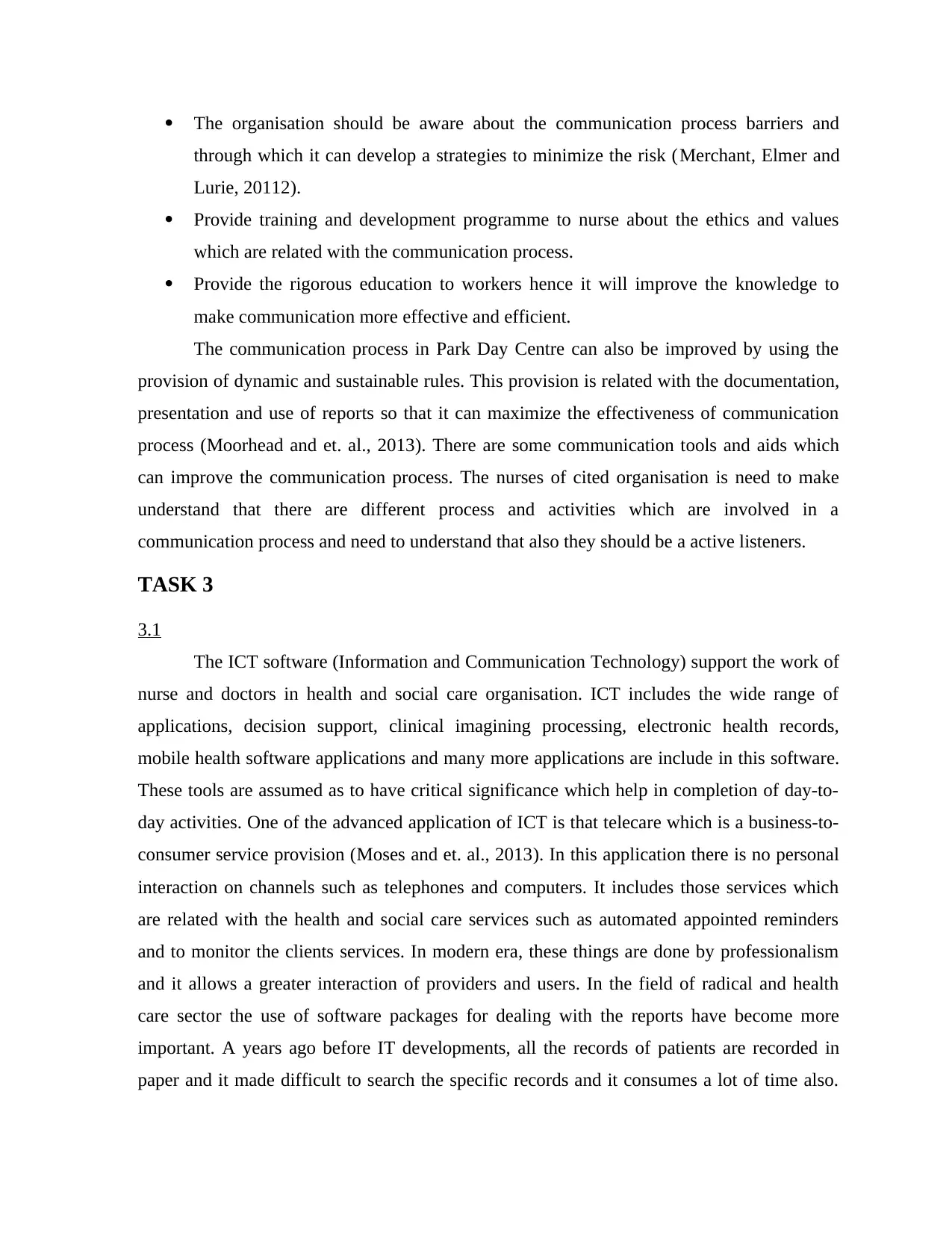
The organisation should be aware about the communication process barriers and
through which it can develop a strategies to minimize the risk (Merchant, Elmer and
Lurie, 20112).
Provide training and development programme to nurse about the ethics and values
which are related with the communication process.
Provide the rigorous education to workers hence it will improve the knowledge to
make communication more effective and efficient.
The communication process in Park Day Centre can also be improved by using the
provision of dynamic and sustainable rules. This provision is related with the documentation,
presentation and use of reports so that it can maximize the effectiveness of communication
process (Moorhead and et. al., 2013). There are some communication tools and aids which
can improve the communication process. The nurses of cited organisation is need to make
understand that there are different process and activities which are involved in a
communication process and need to understand that also they should be a active listeners.
TASK 3
3.1
The ICT software (Information and Communication Technology) support the work of
nurse and doctors in health and social care organisation. ICT includes the wide range of
applications, decision support, clinical imagining processing, electronic health records,
mobile health software applications and many more applications are include in this software.
These tools are assumed as to have critical significance which help in completion of day-to-
day activities. One of the advanced application of ICT is that telecare which is a business-to-
consumer service provision (Moses and et. al., 2013). In this application there is no personal
interaction on channels such as telephones and computers. It includes those services which
are related with the health and social care services such as automated appointed reminders
and to monitor the clients services. In modern era, these things are done by professionalism
and it allows a greater interaction of providers and users. In the field of radical and health
care sector the use of software packages for dealing with the reports have become more
important. A years ago before IT developments, all the records of patients are recorded in
paper and it made difficult to search the specific records and it consumes a lot of time also.
through which it can develop a strategies to minimize the risk (Merchant, Elmer and
Lurie, 20112).
Provide training and development programme to nurse about the ethics and values
which are related with the communication process.
Provide the rigorous education to workers hence it will improve the knowledge to
make communication more effective and efficient.
The communication process in Park Day Centre can also be improved by using the
provision of dynamic and sustainable rules. This provision is related with the documentation,
presentation and use of reports so that it can maximize the effectiveness of communication
process (Moorhead and et. al., 2013). There are some communication tools and aids which
can improve the communication process. The nurses of cited organisation is need to make
understand that there are different process and activities which are involved in a
communication process and need to understand that also they should be a active listeners.
TASK 3
3.1
The ICT software (Information and Communication Technology) support the work of
nurse and doctors in health and social care organisation. ICT includes the wide range of
applications, decision support, clinical imagining processing, electronic health records,
mobile health software applications and many more applications are include in this software.
These tools are assumed as to have critical significance which help in completion of day-to-
day activities. One of the advanced application of ICT is that telecare which is a business-to-
consumer service provision (Moses and et. al., 2013). In this application there is no personal
interaction on channels such as telephones and computers. It includes those services which
are related with the health and social care services such as automated appointed reminders
and to monitor the clients services. In modern era, these things are done by professionalism
and it allows a greater interaction of providers and users. In the field of radical and health
care sector the use of software packages for dealing with the reports have become more
important. A years ago before IT developments, all the records of patients are recorded in
paper and it made difficult to search the specific records and it consumes a lot of time also.
⊘ This is a preview!⊘
Do you want full access?
Subscribe today to unlock all pages.

Trusted by 1+ million students worldwide
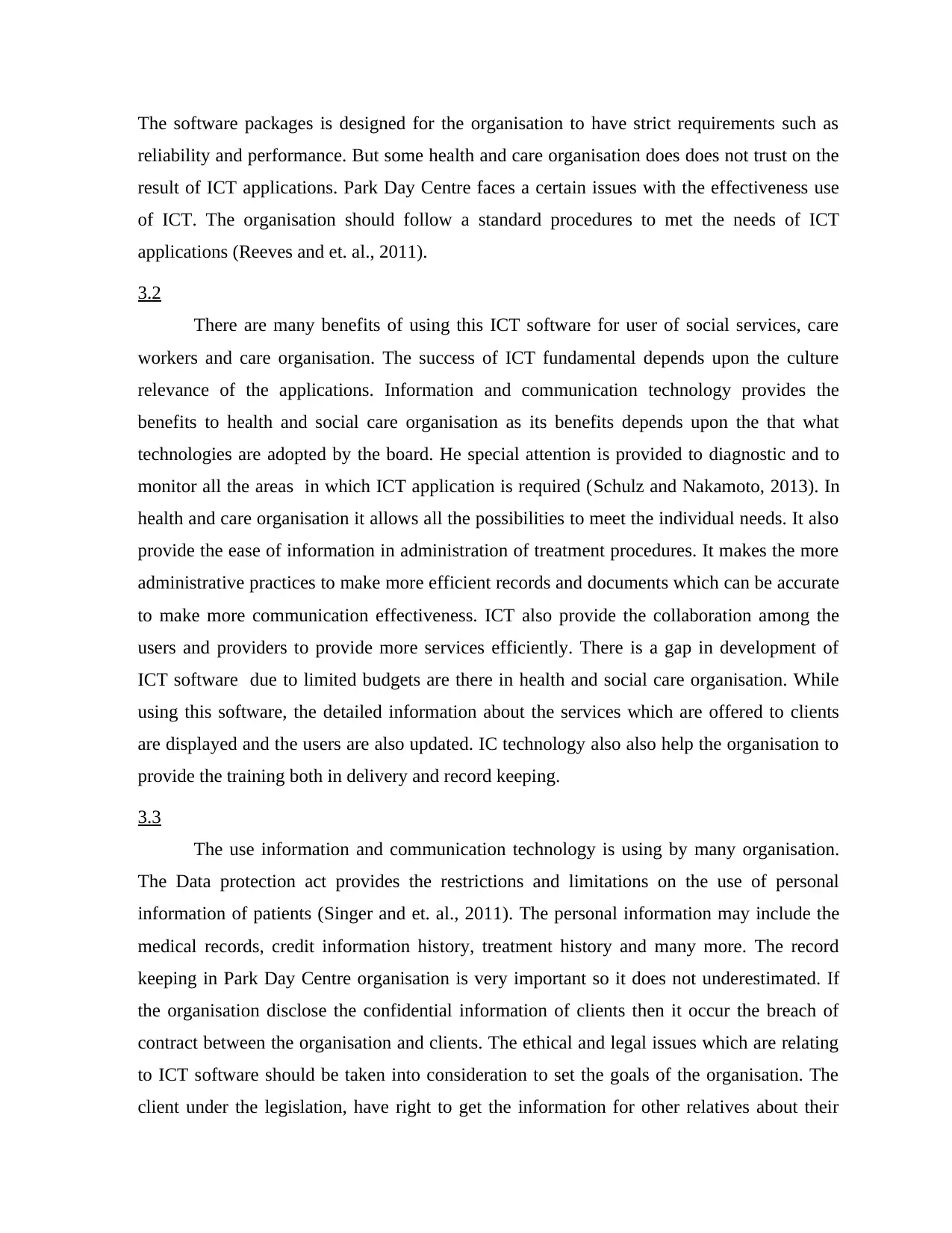
The software packages is designed for the organisation to have strict requirements such as
reliability and performance. But some health and care organisation does does not trust on the
result of ICT applications. Park Day Centre faces a certain issues with the effectiveness use
of ICT. The organisation should follow a standard procedures to met the needs of ICT
applications (Reeves and et. al., 2011).
3.2
There are many benefits of using this ICT software for user of social services, care
workers and care organisation. The success of ICT fundamental depends upon the culture
relevance of the applications. Information and communication technology provides the
benefits to health and social care organisation as its benefits depends upon the that what
technologies are adopted by the board. He special attention is provided to diagnostic and to
monitor all the areas in which ICT application is required (Schulz and Nakamoto, 2013). In
health and care organisation it allows all the possibilities to meet the individual needs. It also
provide the ease of information in administration of treatment procedures. It makes the more
administrative practices to make more efficient records and documents which can be accurate
to make more communication effectiveness. ICT also provide the collaboration among the
users and providers to provide more services efficiently. There is a gap in development of
ICT software due to limited budgets are there in health and social care organisation. While
using this software, the detailed information about the services which are offered to clients
are displayed and the users are also updated. IC technology also also help the organisation to
provide the training both in delivery and record keeping.
3.3
The use information and communication technology is using by many organisation.
The Data protection act provides the restrictions and limitations on the use of personal
information of patients (Singer and et. al., 2011). The personal information may include the
medical records, credit information history, treatment history and many more. The record
keeping in Park Day Centre organisation is very important so it does not underestimated. If
the organisation disclose the confidential information of clients then it occur the breach of
contract between the organisation and clients. The ethical and legal issues which are relating
to ICT software should be taken into consideration to set the goals of the organisation. The
client under the legislation, have right to get the information for other relatives about their
reliability and performance. But some health and care organisation does does not trust on the
result of ICT applications. Park Day Centre faces a certain issues with the effectiveness use
of ICT. The organisation should follow a standard procedures to met the needs of ICT
applications (Reeves and et. al., 2011).
3.2
There are many benefits of using this ICT software for user of social services, care
workers and care organisation. The success of ICT fundamental depends upon the culture
relevance of the applications. Information and communication technology provides the
benefits to health and social care organisation as its benefits depends upon the that what
technologies are adopted by the board. He special attention is provided to diagnostic and to
monitor all the areas in which ICT application is required (Schulz and Nakamoto, 2013). In
health and care organisation it allows all the possibilities to meet the individual needs. It also
provide the ease of information in administration of treatment procedures. It makes the more
administrative practices to make more efficient records and documents which can be accurate
to make more communication effectiveness. ICT also provide the collaboration among the
users and providers to provide more services efficiently. There is a gap in development of
ICT software due to limited budgets are there in health and social care organisation. While
using this software, the detailed information about the services which are offered to clients
are displayed and the users are also updated. IC technology also also help the organisation to
provide the training both in delivery and record keeping.
3.3
The use information and communication technology is using by many organisation.
The Data protection act provides the restrictions and limitations on the use of personal
information of patients (Singer and et. al., 2011). The personal information may include the
medical records, credit information history, treatment history and many more. The record
keeping in Park Day Centre organisation is very important so it does not underestimated. If
the organisation disclose the confidential information of clients then it occur the breach of
contract between the organisation and clients. The ethical and legal issues which are relating
to ICT software should be taken into consideration to set the goals of the organisation. The
client under the legislation, have right to get the information for other relatives about their
Paraphrase This Document
Need a fresh take? Get an instant paraphrase of this document with our AI Paraphraser
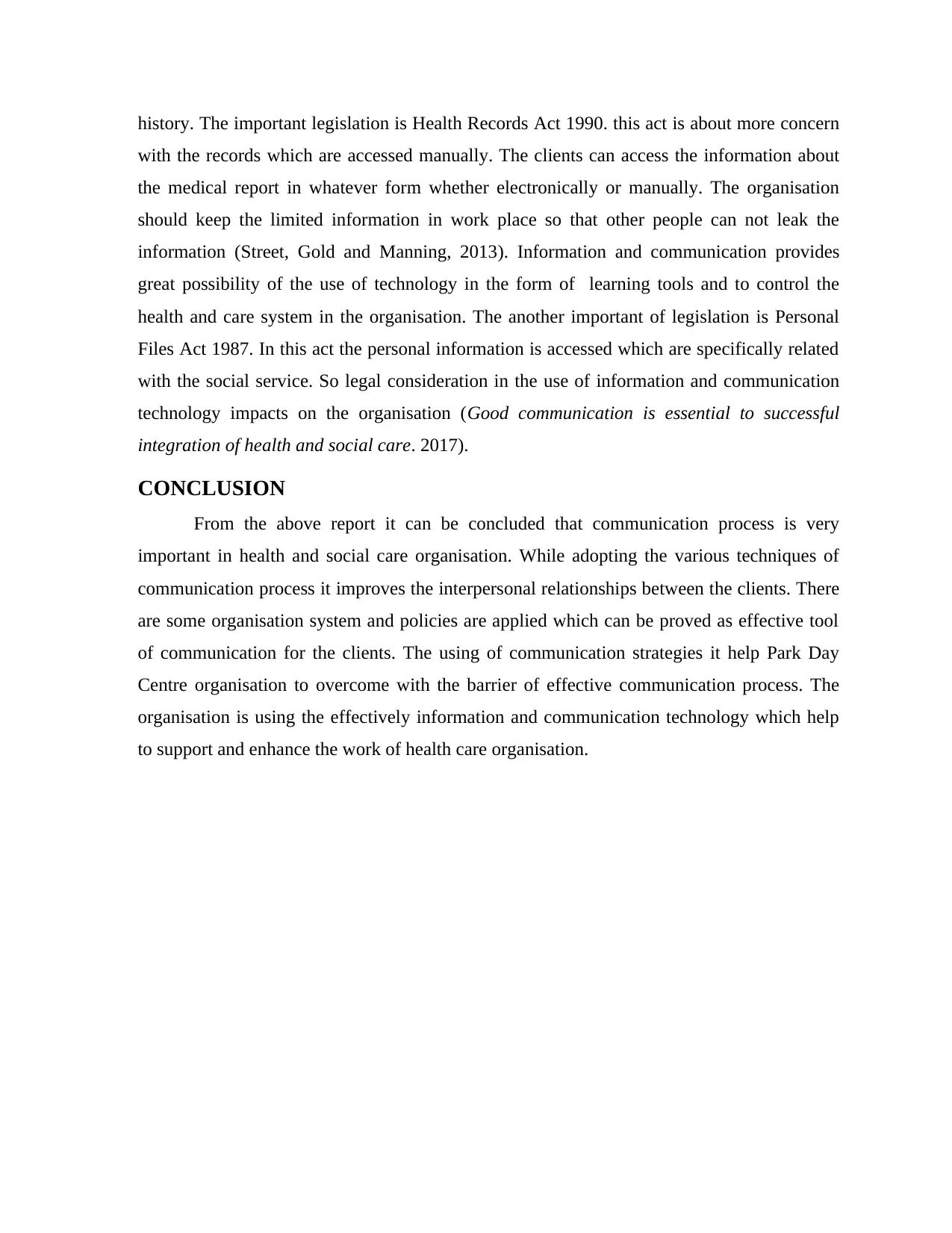
history. The important legislation is Health Records Act 1990. this act is about more concern
with the records which are accessed manually. The clients can access the information about
the medical report in whatever form whether electronically or manually. The organisation
should keep the limited information in work place so that other people can not leak the
information (Street, Gold and Manning, 2013). Information and communication provides
great possibility of the use of technology in the form of learning tools and to control the
health and care system in the organisation. The another important of legislation is Personal
Files Act 1987. In this act the personal information is accessed which are specifically related
with the social service. So legal consideration in the use of information and communication
technology impacts on the organisation (Good communication is essential to successful
integration of health and social care. 2017).
CONCLUSION
From the above report it can be concluded that communication process is very
important in health and social care organisation. While adopting the various techniques of
communication process it improves the interpersonal relationships between the clients. There
are some organisation system and policies are applied which can be proved as effective tool
of communication for the clients. The using of communication strategies it help Park Day
Centre organisation to overcome with the barrier of effective communication process. The
organisation is using the effectively information and communication technology which help
to support and enhance the work of health care organisation.
with the records which are accessed manually. The clients can access the information about
the medical report in whatever form whether electronically or manually. The organisation
should keep the limited information in work place so that other people can not leak the
information (Street, Gold and Manning, 2013). Information and communication provides
great possibility of the use of technology in the form of learning tools and to control the
health and care system in the organisation. The another important of legislation is Personal
Files Act 1987. In this act the personal information is accessed which are specifically related
with the social service. So legal consideration in the use of information and communication
technology impacts on the organisation (Good communication is essential to successful
integration of health and social care. 2017).
CONCLUSION
From the above report it can be concluded that communication process is very
important in health and social care organisation. While adopting the various techniques of
communication process it improves the interpersonal relationships between the clients. There
are some organisation system and policies are applied which can be proved as effective tool
of communication for the clients. The using of communication strategies it help Park Day
Centre organisation to overcome with the barrier of effective communication process. The
organisation is using the effectively information and communication technology which help
to support and enhance the work of health care organisation.
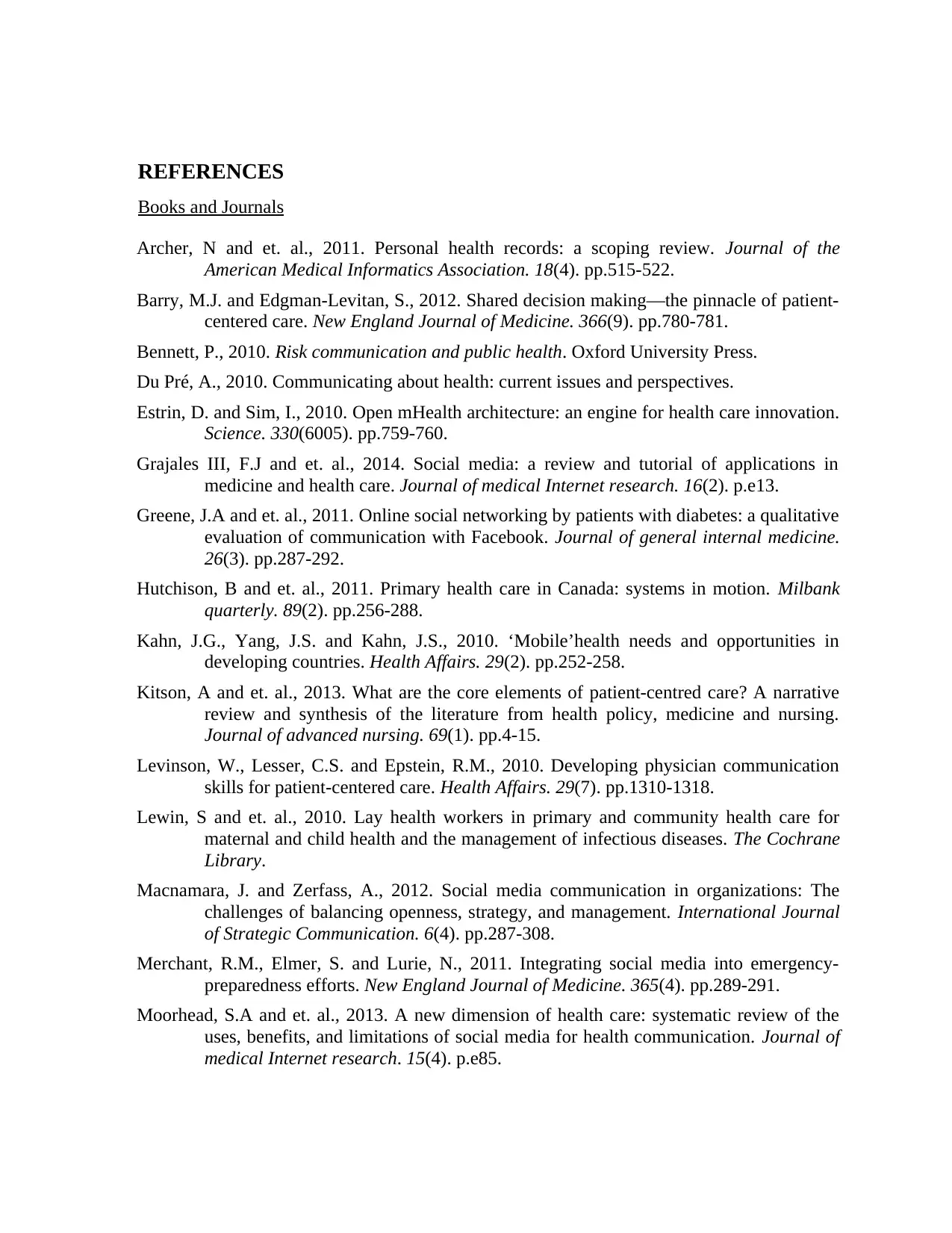
REFERENCES
Books and Journals
Archer, N and et. al., 2011. Personal health records: a scoping review. Journal of the
American Medical Informatics Association. 18(4). pp.515-522.
Barry, M.J. and Edgman-Levitan, S., 2012. Shared decision making—the pinnacle of patient-
centered care. New England Journal of Medicine. 366(9). pp.780-781.
Bennett, P., 2010. Risk communication and public health. Oxford University Press.
Du Pré, A., 2010. Communicating about health: current issues and perspectives.
Estrin, D. and Sim, I., 2010. Open mHealth architecture: an engine for health care innovation.
Science. 330(6005). pp.759-760.
Grajales III, F.J and et. al., 2014. Social media: a review and tutorial of applications in
medicine and health care. Journal of medical Internet research. 16(2). p.e13.
Greene, J.A and et. al., 2011. Online social networking by patients with diabetes: a qualitative
evaluation of communication with Facebook. Journal of general internal medicine.
26(3). pp.287-292.
Hutchison, B and et. al., 2011. Primary health care in Canada: systems in motion. Milbank
quarterly. 89(2). pp.256-288.
Kahn, J.G., Yang, J.S. and Kahn, J.S., 2010. ‘Mobile’health needs and opportunities in
developing countries. Health Affairs. 29(2). pp.252-258.
Kitson, A and et. al., 2013. What are the core elements of patient‐centred care? A narrative
review and synthesis of the literature from health policy, medicine and nursing.
Journal of advanced nursing. 69(1). pp.4-15.
Levinson, W., Lesser, C.S. and Epstein, R.M., 2010. Developing physician communication
skills for patient-centered care. Health Affairs. 29(7). pp.1310-1318.
Lewin, S and et. al., 2010. Lay health workers in primary and community health care for
maternal and child health and the management of infectious diseases. The Cochrane
Library.
Macnamara, J. and Zerfass, A., 2012. Social media communication in organizations: The
challenges of balancing openness, strategy, and management. International Journal
of Strategic Communication. 6(4). pp.287-308.
Merchant, R.M., Elmer, S. and Lurie, N., 2011. Integrating social media into emergency-
preparedness efforts. New England Journal of Medicine. 365(4). pp.289-291.
Moorhead, S.A and et. al., 2013. A new dimension of health care: systematic review of the
uses, benefits, and limitations of social media for health communication. Journal of
medical Internet research. 15(4). p.e85.
Books and Journals
Archer, N and et. al., 2011. Personal health records: a scoping review. Journal of the
American Medical Informatics Association. 18(4). pp.515-522.
Barry, M.J. and Edgman-Levitan, S., 2012. Shared decision making—the pinnacle of patient-
centered care. New England Journal of Medicine. 366(9). pp.780-781.
Bennett, P., 2010. Risk communication and public health. Oxford University Press.
Du Pré, A., 2010. Communicating about health: current issues and perspectives.
Estrin, D. and Sim, I., 2010. Open mHealth architecture: an engine for health care innovation.
Science. 330(6005). pp.759-760.
Grajales III, F.J and et. al., 2014. Social media: a review and tutorial of applications in
medicine and health care. Journal of medical Internet research. 16(2). p.e13.
Greene, J.A and et. al., 2011. Online social networking by patients with diabetes: a qualitative
evaluation of communication with Facebook. Journal of general internal medicine.
26(3). pp.287-292.
Hutchison, B and et. al., 2011. Primary health care in Canada: systems in motion. Milbank
quarterly. 89(2). pp.256-288.
Kahn, J.G., Yang, J.S. and Kahn, J.S., 2010. ‘Mobile’health needs and opportunities in
developing countries. Health Affairs. 29(2). pp.252-258.
Kitson, A and et. al., 2013. What are the core elements of patient‐centred care? A narrative
review and synthesis of the literature from health policy, medicine and nursing.
Journal of advanced nursing. 69(1). pp.4-15.
Levinson, W., Lesser, C.S. and Epstein, R.M., 2010. Developing physician communication
skills for patient-centered care. Health Affairs. 29(7). pp.1310-1318.
Lewin, S and et. al., 2010. Lay health workers in primary and community health care for
maternal and child health and the management of infectious diseases. The Cochrane
Library.
Macnamara, J. and Zerfass, A., 2012. Social media communication in organizations: The
challenges of balancing openness, strategy, and management. International Journal
of Strategic Communication. 6(4). pp.287-308.
Merchant, R.M., Elmer, S. and Lurie, N., 2011. Integrating social media into emergency-
preparedness efforts. New England Journal of Medicine. 365(4). pp.289-291.
Moorhead, S.A and et. al., 2013. A new dimension of health care: systematic review of the
uses, benefits, and limitations of social media for health communication. Journal of
medical Internet research. 15(4). p.e85.
⊘ This is a preview!⊘
Do you want full access?
Subscribe today to unlock all pages.

Trusted by 1+ million students worldwide
1 out of 13
Related Documents
Your All-in-One AI-Powered Toolkit for Academic Success.
+13062052269
info@desklib.com
Available 24*7 on WhatsApp / Email
![[object Object]](/_next/static/media/star-bottom.7253800d.svg)
Unlock your academic potential
Copyright © 2020–2025 A2Z Services. All Rights Reserved. Developed and managed by ZUCOL.





